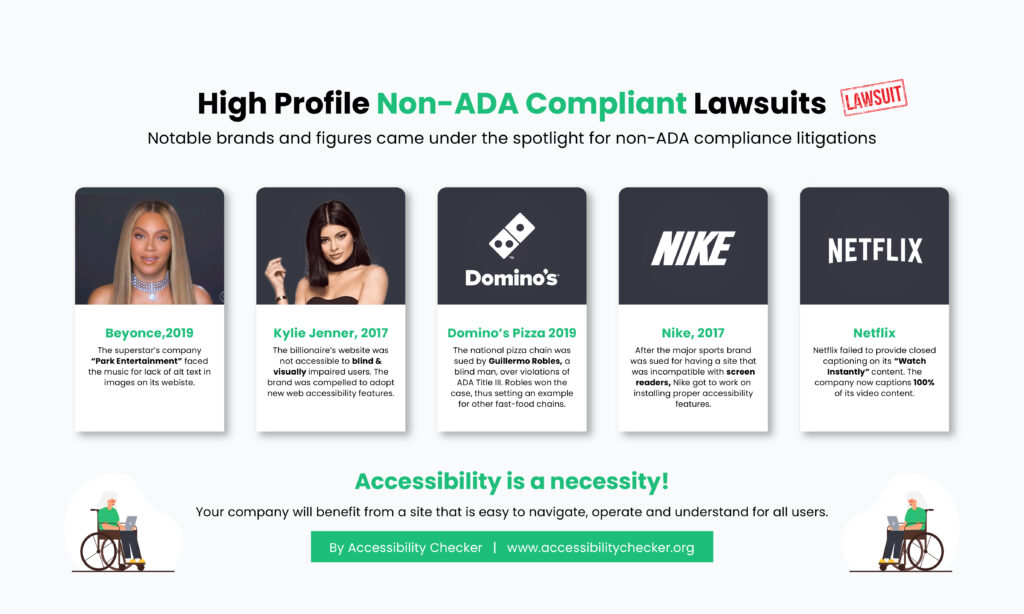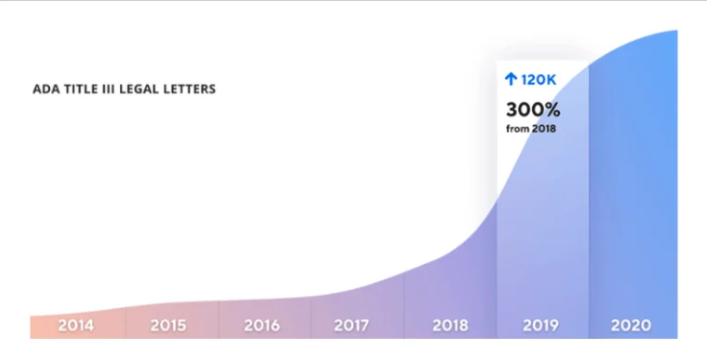Civil lawsuits are flooding the mailboxes of companies that violate ADA guidelines.
Recent statistics indicate that over 80% of all ADA violations occur in just ten counties in California and New York, making the ADA the most heavily litigated federal disability law in the country.
These lawsuits have become a significant expense, but they can be avoided.
Continue reading to learn more about the current landscape of ADA compliance lawsuits and how to avoid getting sued.
In 1990, President Bush signed the ADA to prohibit discrimination against differently-abled people. It’s a civil rights law that prohibits discrimination based on disability in employment, public accommodations, and public services.
In 1991, the Department of Justice issued Title II and Title III rules.
Title II relates to government states and agencies and prohibits them from discriminating against differently-abled people.
Its goal is to protect disabled individuals from discrimination in state and local government programs, services, and activities. What we now know as Section 508 falls under Title II.
Title III prohibits discrimination at places defined as a public accommodation.
These places are generally open to the public and fall under 12 categories, including schools, recreation, offices, and medical buildings. Websites now also fall under Title III. However, there are no formal laws that enforce website accessibility.
To achieve ADA compliance and ensure web accessibility, businesses generally adhere to WCAG and other guidelines. But, there’s no specific law to monitor their practical implications because Title III doesn’t explicitly declare websites as a public accommodation.
Web accessibility litigation is a growing problem. In 2020, the U.S. Department of Justice set a record for ADA Title III lawsuits, filing 10,982 cases. These cases affected both large and small businesses.
One of the most popular ADA compliance lawsuits is Domino’s Pizza v. Guillermo Robles.
Robles is a blind man who sued Domino’s pizza after ordering through the pizza giant’s website and mobile app.
Robles’ attorneys emphasized that the ADA requires businesses with physical locations to make their websites and other online platforms accessible to differently-abled people.
Dominos sought to dismiss the case, initially awarded by the district court that first heard the case. However, Robles filed for an appeal, and the 9th Circuit Court of Appeals in San Francisco ruled in his favor.
The pizza giant appealed to the US Supreme Court. However, the Supreme Court refused to hear the company’s appeal, so Domino’s Pizza will have to continue fighting this case in court.

Another popular website accessibility case is Gill v. Winn-Dixie. It’s the first accessibility case that went to trial and had a decision rendered on its merits.
The plaintiff, who is legally blind, claims that the content of the Winn-Dixie website was inaccessible to him.
The trial was held in the US District Court Southern District of Florida, which ruled in favor of the plaintiff.
Additionally, the court found that there were accessibility issues on the website. As such, Winn-Dixie violated the ADA.
However, Gill v. Winn-Dixie is an important case because the eleventh circuit reversed the district court decision.
The 11th circuit found that Winn-Dixie didn’t violate the ADA because websites aren’t places of public accommodation. Moreover, they also found that the plaintiff wasn’t denied access to any goods or services that Winn-Dixie’s physical location offers.
ADA compliance lawsuits are filed across different verticals, sizes, and industries. Aside from Domino’s case and Gill v. Winn-Dixie, there are also website accessibility complaints against Beyonce (1).
Accessibility lawsuits began to surface in 2013, during which plaintiffs filed 2,722 cases.
This number has recently grown, with 10,982 lawsuits filed in 2020.
While state court data is unreliable due to constraints, all signs indicate a drastic increase in state court filings. New York and California have been the two states with the highest state court filings in recent years.

Even though cases have decreased slightly, a large number of lawsuits have still been filed since a pandemic gripped the country.
ADA compliance lawsuits began steadily increasing in 2021. In January 2021, plaintiffs filed 1,108 cases – the most cases filed in a single month.
With these statistics, ADA compliance lawsuits have nowhere to go but up.
A Fast and Efficient Way to Comply with Web Accessibility Guidelines
Our top-recommended web accessibility solution is accessiBe. This advanced AI-powered tool makes it easier to apply the latest WCAG standards to your site by simply adding a line of code to the back-end.
So, what exactly happens when you get sued?
1) The demand letter arrives.
The first step in an ADA compliance lawsuit is the demand letter. Many of these demand letters contain the same information from one lawsuit to the next.
Nonetheless, you must review the claims in the letter and determine if they’re relevant to your digital assets.
2) Look for legal counsel.
Of course, you need a lawyer for your case. While it can get expensive, finding one with expertise in internet accessibility law and equal rights is the way to go.
With the help of your lawyer, you can build a case and disprove the claims. The goal here is to create a solid defense that proves your website is accessible.
3) Go to trial.
Once your defense is ready, you’ll likely go to trial. Remember that penalties apply for missing a trial, ranging from $50,000 to $100,000.
4) Make the case.
An expert must attest to this fact if you’re correct and your site is accessible. You won’t have to hire an expert if you’re a web developer.
However, you have to hire an unbiased technical expert to witness your case if you aren’t. They must have the technical knowledge to provide detailed testimony on the technical aspects of your site.
5) It isn’t over yet.
You technically win the case if your site is proven to be compliant. However, the plaintiff can still file an appeal to higher courts.
If your site is noncompliant, then prepare for things to get even more expensive. You will be expected to pay a fine at the judge’s discretion.
Here’s something to remember: some lawyers exploit the law and file the lawsuit directly. There’s also something called ADA lawsuit abuse.
ADA lawsuit abuse occurs when an individual files ADA compliance lawsuits without suffering real injuries.
It usually involves a person visiting several business establishments to identify ADA violations, like lack of wheelchair ramps. Then, the individual will proceed to sue the business for injuries.
Now’s a great time to ensure you’re not easy prey. Enter your website in the free accessibility checker below for a full report.
Lawsuits can get expensive quickly, so you want to avoid them as much as possible.
This is how you can do that.
As a business, your social responsibility is to promote inclusivity by making your website accessible.
Even if there is no law, accessibility can benefit your business by broadening your customer base and strengthening your brand.
Start by conducting an audit to understand where your website lies on the scale of accessibility, and then make an effort to make the necessary changes.
Audit your website today on Accessibility Checker
Found this article useful? Check other informative guides here